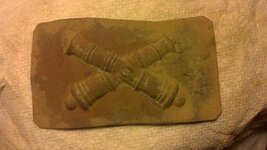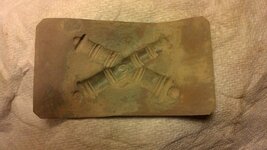Found this yesterday, so far it has not been ID'ed in any of the books. It is one piece stamped brass, looks like there were hook on the reverse. It is a lot like a crossed rifle hat plate I saw dug in he same area. Circa 1830 - 1850s. I hae checked all the books and googlrd till I can't google no more!
If anyone ha any ideas, please let me know. There were bother Artty and rifle militia in the area during the time .
Update: It is 3 1/4" by 1 3/4". It looks like it had solder marks on the reverse, typical of the small wire you see on hat plates. It is very thin, so I have my doubts about it being a belt plate. The area it came from has produced everything from very early Virginia buttons to eagle and US belt plates. First picture is the obverse and the second is the reverse.
Thanks!
If anyone ha any ideas, please let me know. There were bother Artty and rifle militia in the area during the time .
Update: It is 3 1/4" by 1 3/4". It looks like it had solder marks on the reverse, typical of the small wire you see on hat plates. It is very thin, so I have my doubts about it being a belt plate. The area it came from has produced everything from very early Virginia buttons to eagle and US belt plates. First picture is the obverse and the second is the reverse.
Thanks!
Amazon Forum Fav 👍
Attachments
Last edited:







